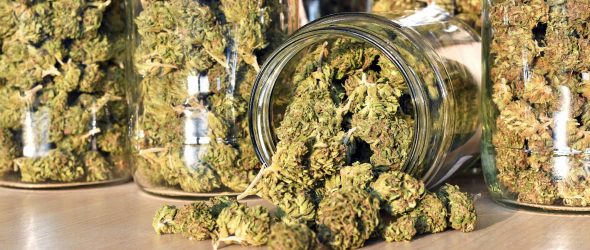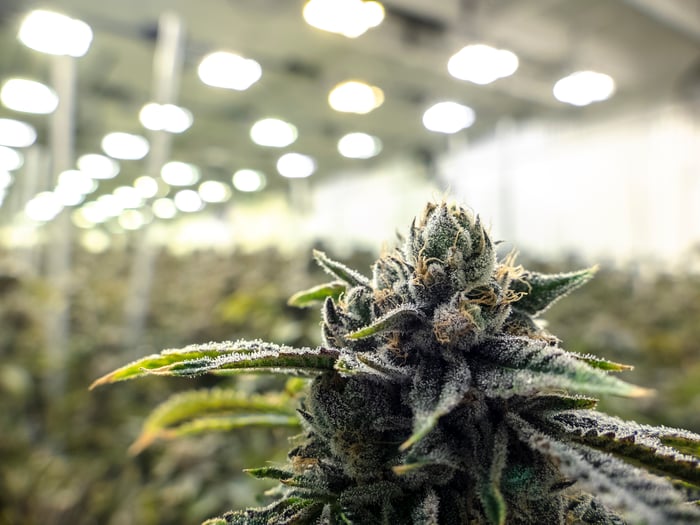 https://cannabisexaminers.com/wp-content/uploads/2020/02/cannabis-jars-marijuana-pot-weed-canada-legal-getty.jpg
https://cannabisexaminers.com/wp-content/uploads/2020/02/cannabis-jars-marijuana-pot-weed-canada-legal-getty.jpg
In case you haven’t noticed, the North American cannabis industry has been a borderline mess in recent months. To our north, Canada has been contending with regulatory-based supply issues that have created shortages or bottlenecks. Meanwhile, in the U.S., high tax rates, and to a lesser degree supply issues, have stymied legal-channel sales. No matter the problem, it’s opened the door for black-market producers to thrive.
But this isn’t all. Individually, financing remains a serious concern for a number of cannabis stocks, as does investor trust following a number of breaches of that trust in 2019. Goodwill has also become a prevailing issue for a handful of marijuana companies.
Unfortunately, there’s yet another balance sheet statistic to add to the worry column, at least for Canadian growers: inventory.

Image source: Getty Images.
Cannabis inventory levels are rising in Canada
Generally speaking, building up inventory has been viewed as a positive thing for the Canadian pot industry. The expectation has been that consumer demand would ramp up for a couple of years, with Canadian growers benefiting from the ability to also export their product to overseas markets. In effect, inventory levels (represented in dollar amounts on balance sheets) would eventually balance out as growers find a healthy equilibrium between supply and demand.
But few folks could have foreseen just how slow the ramp-up in sales has been domestically for Canadian pot stocks. First, Health Canada was slow to approve cultivation and sales licensing applications, which led to supply shortages when adult-use sales commenced in October 2018. Then, last year, Health Canada delayed the launch of higher-margin derivatives by two months. A number of these alternative consumptions options are still not on dispensary shelves in Canada.
Regulatory issues with certain provinces are also to blame. Ontario, the country’s most populous province, had a mere 24 dispensaries open at the one-year anniversary mark of adult-use weed sales commencing. For context, that’s one retail store for every 604,000 people in the province, and it’s created supply bottlenecks galore in the region. All of these factors have made illicit cannabis attractive with consumers, and it’s caused legal-channel marijuana inventory to build to potentially dangerous levels.

Image source: Getty Images.
Canopy Growth could be facing substantive inventory writedowns…
Earlier this week, MKM Partners’ covering analyst Bill Kirk recognized this inventory issue when putting out a research note that left Canopy Growth‘s (NYSE:CGC) rating of neutral unchanged, but reduced his firm’s price target on the company to $21 Canadian ($15.85) from CA$23.
Kirk noted that Canopy’s production has outpaced what the company has sold since Dec. 31, 2017, by 115,000 kilos. By comparison, run-rate demand for the entire Canadian market has only been approximately 180,000 kilos per year. Said Kirk:
On an annual basis, the entire legal market is ~ 180,000 kgs (run rate), suggesting Canopy carries > 50% of industry wide needs for the year (some may be CBD inventory in U.S.). Assuming Canopy ceased all growing operations AND maintained current market share, it would take ~ 2.5 years to sell this product in Canada.
Furthermore, Kirk believes this buildup in inventory isn’t finished. He and his team believe Canopy may have no choice but to either get more price-competitive with its product or risk destroying or writing down the value of some of its inventoried cannabis.

Image source: Getty Images.
… But so might the entire Canadian marijuana industry
The thing is, Canopy Growth may not be alone. We’ve witnessed inventory levels rising pretty significantly across the board in the Canadian cannabis space. Here’s a rundown of the latest inventory figures from some of the most prominent growers to our north:
- Canopy Growth: CA$622.6 million
- Aurora Cannabis (NYSE:ACB): CA$205.5 million
- Aphria: CA$152.2 million
- Tilray: CA$146.4 million
- OrganiGram Holdings: CA$101.9 million
- HEXO (NYSE:HEXO): CA$83.9 million
- Cronos Group: CA$52.9 million
- Auxly Cannabis Group: CA$48.1 million
Mind you, this list doesn’t include a number of mid-tier, small, and privately held growers. Even so, just these eight growers account for CA$1.41 billion in cannabis inventory on their balance sheets, which translates into $1.07 billion U.S.
For context, Canadians spent about CA$1 billion ($755 million) on legal marijuana in the first trailing 12 months since sales commenced on Oct. 17, 2018. This suggests that there might be enough inventory in the pipeline right now, inclusive of all smaller and privately held cultivators, to sustain consumers for the next two years without having to grow a single plant. That’s terrible news if you’re a Canadian pot stock investor and hoping for improved margins.

Image source: Getty Images.
Can cultivators cut output fast enough?
Although we’ve witnessed a number of cannabis stocks reducing their expenditures in recent months to conserve cash, these cutbacks may just as much entail the need to lower production in order to limit inventory levels.
Aurora Cannabis, for example, has halted construction on two of its largest grow farms, and recently announced plans to sell its Exeter greenhouse, which was expected to eventually be retrofit to become another key production source. In total, Aurora has shed around 430,000 kilos of peak annual run-rate output in just the past four months.
The same can be said for HEXO, which announced that it would completely idle the Niagara facility and roughly 200,000 square feet of cultivation space at its flagship Gatineau campus. Idling this growing space not only conserves capital, but it’ll likely reduce HEXO’s peak annual output by up to one third.
The question is, can Canadian growers cut production fast enough to ensure that inventory levels don’t get out of hand and require adjustments or writedowns? To be honest, I’m not sure they can. What we do know is that without much of an export presence, at least for the time being, Canadian pot stocks are reliant on provinces like Ontario to fix their problems. This means Canadian inventory levels could get a lot worse before they begin to improve.

